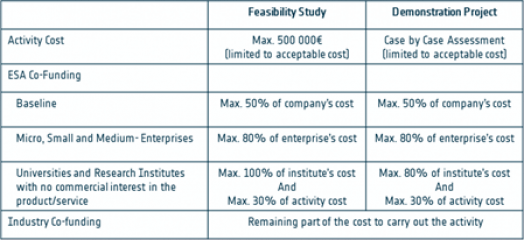This funding call consists of 6 sub-themes, each open at a different point in time. Please see the list of currently open or upcoming funding calls and their further specific details below:
- Smart Cities and Infrastructure: 7 March 2024 – 7 May 2024
- Transportation and Logistics: 26 April 2024 – 26 June 2024
- Energy and Utilities: 23 May - 23 July 2024
- Health and Safety: 17 July - 17 September 2024
- Maritime and Marine: 23 September - 23 November 2024
- Agriculture: Opening 28 October - 15 January 2025
Funding opportunity
There have been remarkable advances in robotics technology in recent years, pushing the boundaries of the possible. Breakthroughs in robotics have resulted in enhanced autonomy, dexterity, and interaction capabilities of robotic systems and have paved the way for significant growth of the robotics market over the past few decades. Today, robots are used across a range of industries, including manufacturing, healthcare, critical infrastructure, agriculture, and logistics, among others. The impact of robotics technologies on society is significant, as it has the potential to transform the way we work, live, and interact with each other. The parallel advancements in the space sector mean that satellite technologies now have the capability to enable novel services utilising robotics on Earth and/or augment their capabilities. As such, the opportunity exists to incorporate robotics and satellite technology to create new commercial services and add value.
The challenge
This Call for Proposals invites proposals for feasibility studies and demonstration projects for services that combine the use of satellite technologies and robotics for downstream services.
Downstream services here refers to activities involving the utilisation of data and services provided by space assets. This component includes satellite communication services, satellite earth observation data, and satellite PNT (positioning, navigation, and timing) services, and other applications that leverage space-based technologies for various industries on Earth. Downstream activities focus on delivering value and insights derived from space-based assets to end-users and businesses.
‘Robotics’ is here defined to include physical robots, autonomous drones, machines and vehicles, and precursory solutions or those that enable these (e.g. perception and navigation systems for autonomous vehicle services, connectivity solutions to enable tele-operated robotics…).
Topics of relevance
This funding call consists of six sub-themes (detailed in the documentation attached below). The dates within which applications will be accepted are listed below:
- Smart Cities and Infrastructure: Support for the construction and maintenance of physical infrastructure, smart city solutions such as waste collection, street cleaning, delivery services, entertainment, and tourism services
- Energy and Utilities: Autonomous infrastructure inspection and maintenance, environmental monitoring, remote installation and energy infrastructure operations
- Transportation and Logistics: Autonomous vehicles and precursor services, logistics automation solutions
- Health and Safety: Drone and robotics-based delivery of supplies, robotic guides for the visually impaired, search and rescue and disaster response
- Maritime: Autonomous surveys and mapping, maintenance of sea-based infrastructure and vessels, port operations automation and security, aquaculture farming, coastal monitoring
- Agriculture: Precision farming, crop cultivation monitoring and optimisation.
Value of space
Satellite Positioning can provide coarse to high accuracy positioning information to robots, vehicles, machines and drones operating in outdoor spaces. This can be used for navigation, geo- and timestamping of collected data, time-synchronisation of networked machines, and/or determination of speed and heading. Satellite positioning could be combined with inertial and alternative positioning techniques to support indoor-outdoor seamless localisation and marine robotics. This could manifest as navigation of autonomous vehicles, geolocation of imagery captured by drones, tracking of search and rescue robots, guidance of agricultural robots and more. Augmentation of GNSS can offer higher positioning accuracies for certain use-cases via solutions such as Galileo HAS (High Accuracy Service), Differential GNSS, RTK (Real-Time Kinematic), or otherwise, with the selection dependent on the service requirements.
Satellite Communications provides data, video and voice communications and may add value to applications implemented in the following service provision scenarios:
- Environments that have inadequate, unreliable, compromised, or altogether absent mobile cellular connectivity.
- Mobile services that operate across regions with varying cellular connectivity quality (good in certain areas, poor in others…) and require continuous coverage and availability.
- Services that have high security, robustness and resilience requirements may benefit from satellite communications for redundancy in compromised or unforeseen circumstances.
These may be pertinent for drone operations in rural areas, autonomous vehicles, or operations of robotics in any of the above given circumstances. New developments in satellite communications may also be exploited, such as Low-Earth Orbit (LEO) Broadband satellite constellations, to enable certain services with demanding performance or cost constraints.
Satellite Earth Observation
Satellite Earth Observation - it is expected that satellite earth observation could support robotics solutions at the service level i.e., providing complementary or enabling datasets to support the activities of the robots. This could be through mapping data to support the navigation of the robot, or collection of datasets that complement those collected by the robot. Satellite earth observation data could refer to air quality measurements, thermal heat signatures, optical, radar, meteorology, or combinations thereof. This could manifest as use of satellites followed by drones or robotics in a “find and refine” approach, or otherwise.
Spaceflight Technology
Spaceflight Technology Spin-Outs - applications of robotics developed for use in space (and other astronomical objects) that also have commercial applications on Earth, i.e. Spaceflight Spin-Outs, are also considered eligible. This could relate to robotics developed for space, tele-robotic solutions and algorithms (perception, planning, control…) developed for autonomy of space robotics, or otherwise.
What we look for
We look for promising business ideas addressing topics of relevance or related areas that propose:
- Attractive market opportunities, identified customer needs and customer engagement
- Commercially-viable service concepts
- Technically feasible solutions
- Added value of space data or technology
- Motivated teams with business, technical, and financial expertise
What we offer
We offer funding and support to companies, both for business case assessment and for the development of new, space-based services. Our offer includes:
- Zero-equity funding*
- Technical and commercial guidance
- Access to our network and partners
- ESA brand credibility
*(50-80% depending on SME Status and Member State Approval)
ESA tender information
The initiative is open to the submission of proposals for Feasibility Studies and Demonstration Projects:
- Feasibility Studies - which provide the preparatory framework to identify, analyse and define new potentially sustainable services
- Demonstration Projects - dedicated to the implementation and demonstration of pre-operational services
How to apply
Once the respective sub-themes are open to proposal submission (opening dates are noted above) details and associated documentation related to the calls for proposals will be made available, including how to apply.
Authorisation of funding
This opportunity is open to companies that intend to develop space-enabled services and products related, but not restricted, to the topics of relevance outlined above. To be eligible for funding, your team must be based in one of the following countries: Austria, Belgium, Czech Republic, Denmark, Estonia, Finland, France, Germany, Hungary, Ireland, Italy, Lithuania, Luxembourg, Norway, Poland, Portugal, Romania, Spain, Slovenia, Sweden, Switzerland, The Netherlands and United Kingdom. Teams can involve non-European entities, but their contribution to the activity cannot be funded by ESA. Authorisation of Funding letters from the corresponding National Delegations are required as part of the application.




